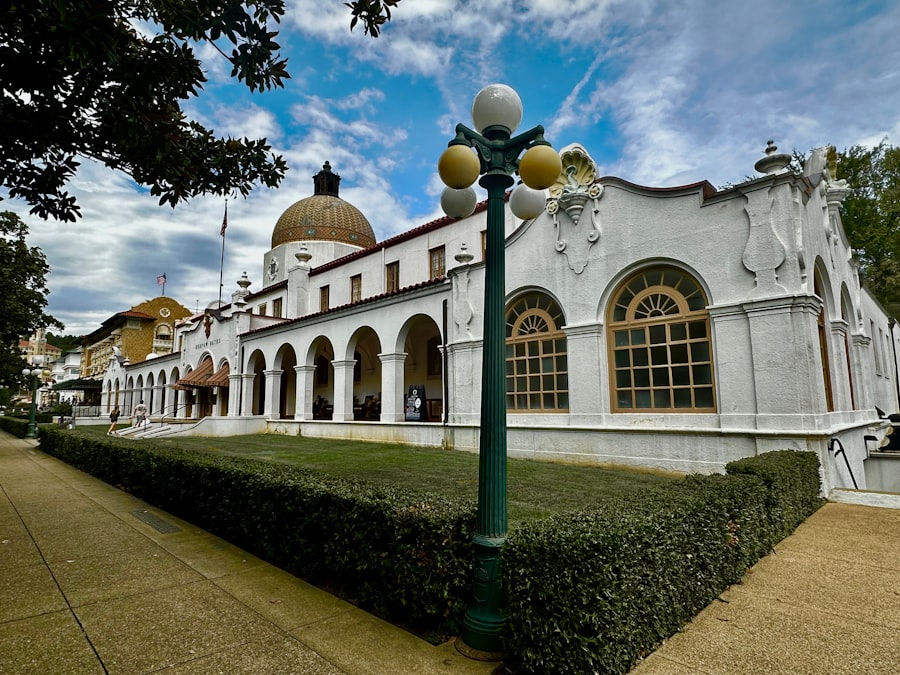Augmented Reality (AR) has emerged as a transformative technology in various sectors, and its application in museums is particularly noteworthy. By overlaying digital information onto the physical world, AR enhances the visitor experience, allowing for a more immersive interaction with exhibits. Museums, as custodians of history and culture, have begun to harness this technology to create engaging narratives that bring historical events to life.
The integration of AR not only enriches the storytelling aspect of exhibitions but also caters to the evolving expectations of modern audiences who seek interactive and participatory experiences. The use of AR in museums is not merely a trend; it represents a significant shift in how institutions present their collections and engage with visitors. Traditional static displays are being transformed into dynamic experiences where users can interact with artifacts in ways that were previously unimaginable.
For instance, through AR applications, visitors can visualize historical figures in their original contexts or witness pivotal moments in history unfold before their eyes. This innovative approach not only captivates audiences but also fosters a deeper understanding of the past, making history more accessible and relatable.
Key Takeaways
- AR in museums enhances visitor experience by providing interactive and immersive ways to engage with historical artifacts and events.
- Using AR for reconstructing historical events allows for a more dynamic and engaging presentation, bringing history to life for visitors.
- Challenges of using AR in museums include technical limitations, cost of implementation, and potential distraction from the museum’s physical artifacts.
- Successful case studies of AR implementation in historical events demonstrate the potential for AR to enhance visitor engagement and learning.
- AR has a significant impact on visitor engagement and learning in museums, providing a more interactive and memorable experience for visitors.
Advantages of Using AR for Reconstructing Historical Events
One of the primary advantages of employing AR in museums is its ability to reconstruct historical events with a level of detail and interactivity that traditional methods cannot achieve. By utilizing AR technology, museums can create vivid reconstructions of significant moments in history, allowing visitors to experience these events as if they were present. For example, an AR application might enable users to witness the signing of a historic treaty or the construction of an ancient monument, complete with contextual information and visual enhancements that provide a richer understanding of the event’s significance.
Moreover, AR facilitates personalized learning experiences tailored to individual interests and knowledge levels. Visitors can choose what aspects of a historical event they wish to explore further, whether it be the social dynamics at play, the technological advancements of the time, or the cultural implications of the event. This level of customization not only enhances engagement but also empowers visitors to take ownership of their learning journey.
By providing multiple layers of information and interactive elements, AR encourages deeper exploration and critical thinking about historical narratives.
Challenges and Limitations of Using AR in Museums
Despite its numerous advantages, the implementation of AR in museums is not without challenges. One significant hurdle is the technological barrier that may exist for both institutions and visitors. Museums must invest in the necessary hardware and software to create AR experiences, which can be costly and resource-intensive.
Additionally, there is a learning curve associated with using AR technology, both for museum staff who must develop and maintain these applications and for visitors who may be unfamiliar with how to engage with them. Another limitation lies in the potential for distraction. While AR can enhance the visitor experience, it can also detract from the appreciation of physical artifacts if not carefully integrated.
Visitors may become so engrossed in their devices that they overlook the tangible elements of an exhibition. Striking a balance between digital engagement and physical interaction is crucial to ensure that AR serves as a complement rather than a replacement for traditional museum experiences. Furthermore, there is a risk that over-reliance on technology could lead to a homogenization of experiences across different institutions, diminishing the unique character of each museum’s offerings.
Case Studies of Successful AR Implementation in Historical Events
Several museums around the world have successfully implemented AR technology to reconstruct historical events, showcasing its potential to enhance visitor engagement and education. One notable example is the Smithsonian National Museum of Natural History in Washington, D.C., which introduced an AR app called “Smithsonian X 3D.” This application allows users to explore 3D models of artifacts and fossils while providing contextual information about their historical significance. Visitors can interact with these models in real-time, gaining insights into their origins and relevance within broader historical narratives.
Another compelling case is the Anne Frank House in Amsterdam, which has utilized AR to provide visitors with a more immersive understanding of Anne Frank’s life during World War
Through an AR app, users can view reconstructions of the secret annex where Anne and her family hid from the Nazis. The app includes audio narratives and visual overlays that contextualize her experiences within the larger framework of the Holocaust. This approach not only humanizes historical events but also fosters empathy and understanding among visitors, making the lessons of history more poignant and impactful.
The Impact of AR on Visitor Engagement and Learning in Museums
The integration of AR technology in museums has significantly transformed visitor engagement and learning outcomes. By creating interactive experiences that captivate audiences, museums can foster a sense of curiosity and exploration that encourages deeper learning.
Furthermore, AR has the potential to attract diverse audiences, including younger generations who are accustomed to digital interactions. By incorporating gamification elements into AR experiences—such as challenges or quests—museums can appeal to this demographic’s desire for interactive learning. For instance, an AR scavenger hunt could guide visitors through an exhibition while prompting them to discover key artifacts and learn about their historical significance along the way.
This approach not only enhances engagement but also promotes social interaction among visitors as they collaborate to complete challenges.
Ethical Considerations in Using AR to Reconstruct Historical Events
While the use of AR in museums offers exciting possibilities, it also raises important ethical considerations that must be addressed. One primary concern is the accuracy and authenticity of historical representations. When reconstructing events through AR, museums have a responsibility to ensure that their portrayals are grounded in rigorous scholarship and reflect diverse perspectives.
Misrepresentation or oversimplification of complex historical narratives can lead to misunderstandings and perpetuate harmful stereotypes. Additionally, there is an ethical imperative to consider the emotional impact of certain historical events when designing AR experiences. For instance, recreating traumatic events such as wars or genocides requires sensitivity and care to avoid trivializing suffering or exploiting tragedy for entertainment purposes.
Museums must engage with historians, cultural experts, and community representatives to navigate these complexities responsibly. By prioritizing ethical considerations in their AR initiatives, museums can foster trust with their audiences and contribute positively to public discourse around history.
Future Trends and Innovations in AR for Museums
As technology continues to evolve, so too will the applications of AR in museums. One emerging trend is the integration of artificial intelligence (AI) with AR experiences, allowing for even more personalized interactions. AI algorithms could analyze visitor behavior and preferences to tailor content dynamically, providing customized narratives that resonate with individual interests.
This level of personalization could enhance engagement further by ensuring that each visitor’s experience is unique. Another promising innovation is the potential for collaborative AR experiences that extend beyond individual visits. Museums could develop platforms that allow users to connect remotely, sharing insights and perspectives while exploring exhibits together through augmented reality.
This could foster a sense of community among museum-goers and expand access to cultural resources for those unable to visit in person. As museums continue to experiment with these technologies, they will likely uncover new ways to engage audiences and present historical events in compelling ways.
The Role of AR in Preserving and Presenting Historical Events in Museums
The integration of augmented reality into museum practices represents a significant advancement in how historical events are preserved and presented to the public. By leveraging this technology, museums can create immersive experiences that not only educate but also inspire curiosity about our shared past. As institutions navigate the challenges associated with implementing AR—such as technological barriers and ethical considerations—they also unlock new opportunities for engagement and learning.
Ultimately, augmented reality has the potential to redefine the museum experience by bridging the gap between history and contemporary audiences. As museums continue to innovate and adapt to changing visitor expectations, AR will play an increasingly vital role in ensuring that historical narratives remain relevant and accessible for future generations. Through thoughtful implementation and ongoing dialogue about its implications, augmented reality can serve as a powerful tool for preserving our collective memory while fostering a deeper understanding of the complexities of history.
The article “The Best Laptops for Graphic Design in 2023” discusses the importance of having the right tools for creating visually appealing content. In the context of reconstructing historical events in museums using AR technology, having a powerful laptop with high-quality graphics capabilities is essential for designing immersive experiences. To learn more about the best laptops for graphic design, check out this article.
FAQs
What is AR?
AR stands for Augmented Reality, which is a technology that superimposes digital information such as images, videos, or 3D models onto the real world environment.
How does AR reconstruct historical events in museums?
AR can reconstruct historical events in museums by overlaying digital content onto physical artifacts or spaces, providing visitors with a more immersive and interactive experience.
What are the benefits of using AR in reconstructing historical events in museums?
Using AR in museums can enhance visitor engagement, provide a deeper understanding of historical events, and bring artifacts to life in a way that traditional exhibits cannot.
Are there any limitations to using AR in museums?
Some limitations of using AR in museums include the cost of implementing the technology, the need for maintenance and updates, and potential technical issues that may arise during visitor interactions.
Can AR be used in all types of museums?
AR can be used in a variety of museums, including history museums, art museums, science museums, and cultural heritage sites, to enhance the visitor experience and provide a new perspective on historical events.



